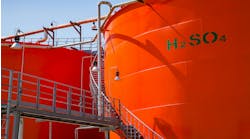A continuous process using enzyme catalyst coated on beads placed in a microreactor provides faster production of polycaprolactone and environmental advantages compared to conventional batch routes for the polymerization, say researchers. They claim this is the first reported demonstration of a solid-supported enzyme-catalyzed polymerization reaction in continuous mode.
The team from the National Institute of Standards and Technology (NIST), Gaithersburg, Md., and the Polytechnic Institute of New York University, Brooklyn, N.Y., converted ε-caprolactone to polycaprolactone. This polymerization usually relies on an organic tin-based catalyst that is toxic; the researchers instead opted for a benign enzyme made by yeast. They used a microreactor consisting of an about 40 mm × 90 mm 10-mm-thick aluminum plate containing a zigzag channel 2-mm wide × 1-mm deep filled with catalyst-covered beads (Figure 1). The beads were loaded by applying a vacuum at the end of the channel. More details appear in a recent article in the Journal of the American Chemical Society.
Using the enzyme in conventional batch reactors doesn't make sense, explains Kathryn Beers of NIST, because its performance there isn't competitive and enzyme residue can contaminate the product.
"With this process engineering approach, we've shown that continuous flow really benefits these reactors. Not only does it dramatically accelerate the rate of reaction but it improves your ability to recover the enzyme and reduce contamination of the product," she says.
"What the flow reactor enables that is so broadly powerful is excellent control of conditions, which leads to things like higher yields, faster rates, improved control of molecular characteristics like chain length, and potentially reduced contamination," she adds. "One thing this work has enabled for us is the development of better monitoring tools for the reaction, which have led to a very sophisticated model of the process and insight into how to improve it further."
"There is definitely a learning curve associated with working in microreactors, especially with polymerization chemistry," Beers notes. "Avoiding clogging is an early part of that curve. Because the physical stresses on the bead support system are reduced, in this case especially because of the removal of aggressive mechanical mixing, less physical deterioration is expected — and observed."
However, the researchers aren't planning to scale up the process. Their mission generally isn't to groom technology for commercialization, she says, but to demonstrate methods and measurements. "It's more important that what we learned from it can be adapted to other related process and measurement problems. The principles are broadly applicable to polyester polymerizations and we are also interested in exploring some related monomer systems and other supported catalysts."



